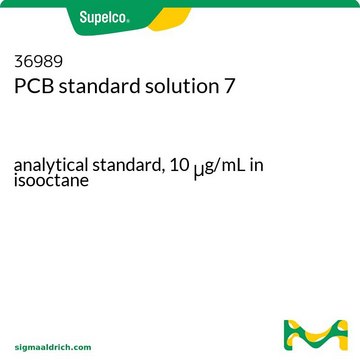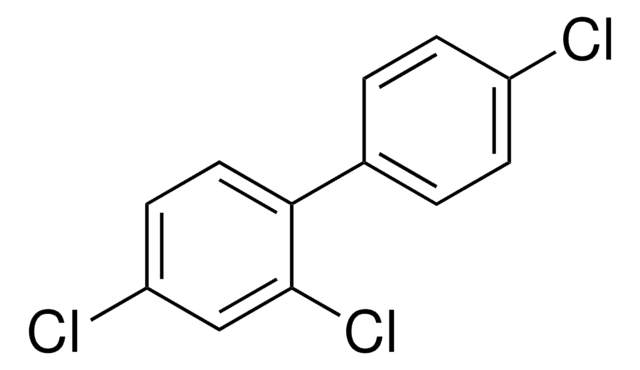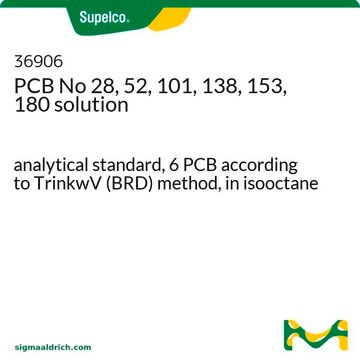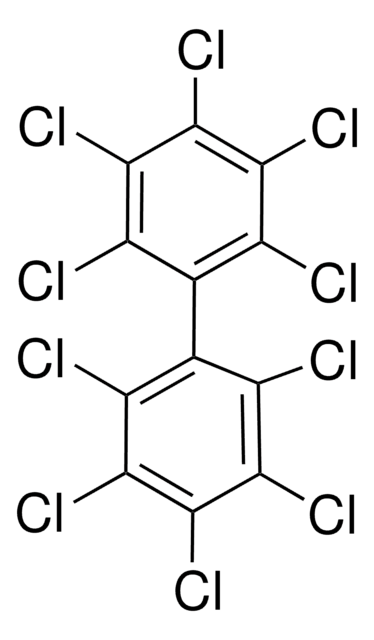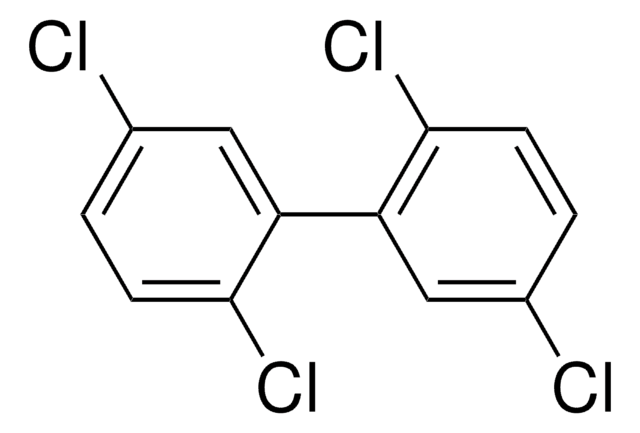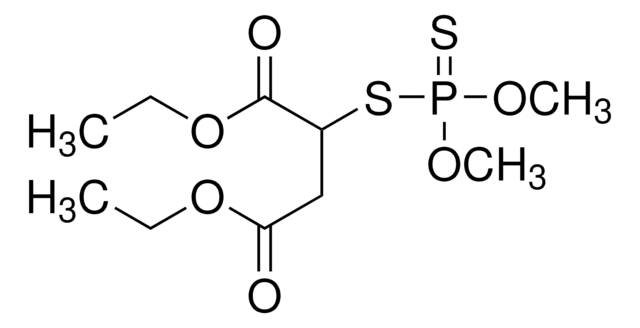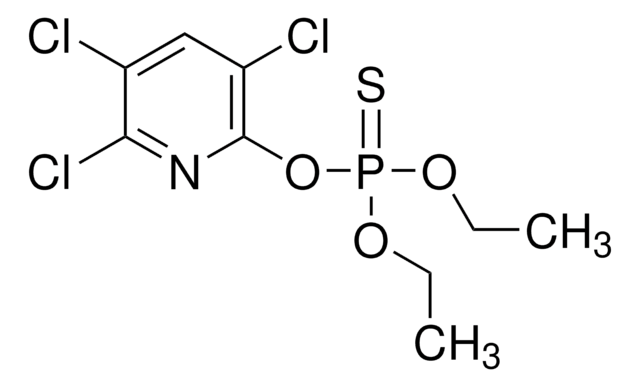おすすめの製品
グレード
analytical standard
品質水準
シェルフライフ
limited shelf life, expiry date on the label
テクニック
HPLC: suitable
gas chromatography (GC): suitable
アプリケーション
environmental
フォーマット
neat
SMILES記法
Clc1cccc(c1)-c2ccccc2
InChI
1S/C12H9Cl/c13-12-8-4-7-11(9-12)10-5-2-1-3-6-10/h1-9H
InChI Key
NMWSKOLWZZWHPL-UHFFFAOYSA-N
類似した製品をお探しですか? 訪問 製品比較ガイド
詳細
Polychlorinated biphenyls (PCBs) are groups of chemical compounds which are persistent in the environment and are considered highly toxic to humans and animals. PCB No 2 may be used for environmental analysis and precise quality control of food and feed.
アプリケーション
Refer to the product′s Certificate of Analysis for more information on a suitable instrument technique. Contact Technical Service for further support.
おすすめ製品
Find a digital Reference Material for this product available on our online platform ChemisTwin® for NMR. You can use this digital equivalent on ChemisTwin® for your sample identity confirmation and compound quantification (with digital external standard). An NMR spectrum of this substance can be viewed and an online comparison against your sample can be performed with a few mouseclicks. Learn more here and start your free trial.
シグナルワード
Warning
危険有害性情報
注意書き
危険有害性の分類
Aquatic Acute 1 - Aquatic Chronic 1 - STOT RE 2
保管分類コード
11 - Combustible Solids
WGK
WGK 3
引火点(°F)
Not applicable
引火点(℃)
Not applicable
個人用保護具 (PPE)
dust mask type N95 (US), Eyeshields, Gloves
適用法令
試験研究用途を考慮した関連法令を主に挙げております。化学物質以外については、一部の情報のみ提供しています。 製品を安全かつ合法的に使用することは、使用者の義務です。最新情報により修正される場合があります。WEBの反映には時間を要することがあるため、適宜SDSをご参照ください。
PRTR
特定第一種指定化学物質
労働安全衛生法名称等を表示すべき危険物及び有害物
名称等を表示すべき危険物及び有害物
労働安全衛生法名称等を通知すべき危険物及び有害物
名称等を通知すべき危険物及び有害物
Jan Code
35592-100MG:
35592-BULK:
35592-VAR:
Role of commensal relationships on the spatial structure of a surface-attached microbial consortium.
A T Nielsen et al.
Environmental microbiology, 2(1), 59-68 (2001-03-13)
A flow cell-grown model consortium consisting of two organisms, Burkholderia sp. LB400 and Pseudomonas sp. B13(FR1), was studied. These bacteria have the potential to interact metabolically because Pseudomonas sp. B13(FR1) can metabolize chlorobenzoate produced by Burkholderia sp. LB400 when grown
R H Adams et al.
Applied and environmental microbiology, 58(2), 647-654 (1992-02-01)
Recombinant Pseudomonas sp. strain CB15, which grows on 3-chlorobiphenyl (3CB), was constructed from Pseudomonas sp. strain HF1, which grows on 3-chlorobenzoate, and from Acinetobacter sp. strain P6, which grows on biphenyl, by using a continuous amalgamated culture apparatus. DNA from
F Fava et al.
Applied microbiology and biotechnology, 36(2), 240-245 (1991-11-01)
A mixed bacterial culture obtained from polychlorinated-biphenyl-contaminated river sediments proved capable of degrading 3-chlorobiphenyl (3-CB) under aerobic laboratory conditions. Almost total mineralization of 150 mg/l of 3-CB occurred when, after 3 days of incubation, the mineral medium was supplied with
B P Maliwal et al.
Journal of lipid research, 23(3), 474-479 (1982-03-01)
The uptake, distribution, and exchange of chlorinated hydrocarbon insecticides (dieldrin and chlordecone) and biphenyls (2,4,5-2',4',5'-hexachlorobiphenyl and 3-chlorobiphenyl) among human lipoproteins was examined by fluorescence quenching, gel filtration, and ultrafiltration. The chlorinated hydrocarbons were rapidly taken up from solution or silica
Q Zhang et al.
Environmental science & technology, 35(24), 4933-4935 (2002-01-05)
Grinding a mixture of 3-chlorobiphenyl (BP-Cl) and CaO with or without the addition of quartz was conducted in air by a planetary ball mill to investigate the mechanochemical dechlorination of BP-Cl. The dechlorinating reaction proceeds with an increase in grinding
ライフサイエンス、有機合成、材料科学、クロマトグラフィー、分析など、あらゆる分野の研究に経験のあるメンバーがおります。.
製品に関するお問い合わせはこちら(テクニカルサービス)